After months of research and testing, my gear list for my Southbound thru-hike of the PCT is complete. Here’s what I’m going to be hauling from Canada to Mexico for the next several months (Part 2).

The past few weeks have been pretty crazy around my parts: I moved into a cabin recently and have been trying to fix it up, maintain my sanity, and find a solution to my rather ‘semi off grid’ situation. At the moment, I have no WiFi and very limited phone service (just the occasional 3G to get me by). Sometimes it’s a blessing, but trying to figure out how to get a well pump to work and how to deal with other plumbing issues often requires streaming YouTube videos.
In addition to that, I quit my job a couple of weeks ago, finally finished putting together all of my resupply boxes, and have been adventuring with my outdoor buddy that I met on an online group for PNW Outdoor Women.

As far as the planning for my thru-hike goes, here’s some quick updates:
You’re all probably wondering when the hell I’m actually going to get around to hiking this damn trail again, since I haven’t shut up about it for the past several months. The northbound hikers are already traversing the Sierra, and here I am talking the talk instead of walking the walk. Southbounders obviously have to do it a bit differently, as we have to wait for the snow up north, where we start, to clear up before we can do the thing.
I’m not procrastinating, I swear.
I’ve had some people asking me why “I’m waiting so long” or “Why didn’t you start when it’s less hot outside.” But I promise I know what I’m doing, for the most part, and this is just the nature of the game.
I pushed my start date back a bit from June 26th, now with a tentative start date of early July. Why? Because we had a high snow pack this winter in the Cascades, with a couple of late spring snow storms to top it off in the north. It’s all melting fairly rapidly now, and should be easy breezy by July. I do expect to encounter some snow early on, especially in the avalanche chutes and on the north faces of the peaks, but I’m comfortable with snow travel and have a good amount of experience under my belt. I’ve been tracking the snow pack at Hart’s Pass using the USDA SNOTEL.
I reached my savings budget of $5000 for my trip a couple of months ago; actually I blew past it. I have more than enough saved to get by with, although I still plan on being as frugal as possible when I’m in town. Here’s my blog post about my Budget for the PCT.

As I already mentioned, I finished assembling my resupply for my thru-hike, with 30 total boxes to be sent out, plus a bounce box. I’ve been toying with the idea of writing a post about what I’m putting in my boxes, as well as covering my strategy for trail towns and my food budget for each location. If you’re interested in that, please leave a comment on this post. I do already have a post that gives advice on resupplying along the PCT, which can be found here.
Now for the important bit: I’m raising money and awareness on my thru-hike for a cause that I’m very passionate about, suicide prevention and mental health awareness. At the time of publication, I’ve reached half of my fundraising goal with The American Foundation for Suicide Prevention! I’m so excited that everyone has taken an interest in my campaign, ‘Hiking for Hope and Healing.’ A very special thanks to all of my donors so far: Hummingbird, Magpie, Sig, Pedro, Ingrid, Goretti, Stephen, Chrissy, Lisae, and all the anonymous contributors who are making mental health a priority in their communities! You can read more about my charity campaign, why suicide prevention is important to me, and how I’m using my thru-hike of the PCT to raise awareness, by clicking here.
To donate and help save lives, please visit my campaign with The American Foundation for Suicide Prevention.

Pacific Crest Trail SOBO Gear List
In case you missed it, I’ve already done a post on what I’m wearing on the trail. I will include some of the weights of the clothing on that list here, with the exception of the actual clothes that I will be hiking in. Also of note, my gear weights do not include consumables, as is standard in gear posts. This means I’m not including the weights of water, fuel, food and some toiletries like toilet paper, sunscreen and toothpaste. This is because these weights are varied and constantly changing with use.
The Big 3
The heaviest and most important gear, plus some of the accessories that go with it.

- Six Moons Designs Lunar Solo Tent, plus Zpacks Tall Dry Bag, Tyvek Ground Sheet, MSR ultralight guy lines and 8 MSR ‘Ground Hog’ Stakes, 34 oz:
I chose this shelter because of its low weight (24 ounces without the Tyvek, stakes and guy lines), and the fact that it still came with a bug net and bathtub floor. There’s basically 2 things I want to keep out of my tent: creepy crawlies and water (ok and probably bears too). This shelter utilizes a trekking pole to pitch, instead of using the added weight of aluminum poles. I’ve used it on a few outings now, and I love that I can sit fully upright in it comfortably, and everything stayed dry when it rained overnight. Since it is a single wall shelter, the downside is that condensation builds up overnight. However, its light weight and ability to pack down extra small overrides that gripe. I swapped out the stuff sack that it came with for one from Zpacks, mostly because I wanted a stuff sack that is waterproof and has a roll top closure so I can compress the shelter down even smaller. The Zpacks Tall Dry Bag is also slightly lighter in weight, and it will fit in the side pouch of my pack. - Therm-a-Rest Mira HD 15 Sleeping Bag, plus Zpacks Medium-Plus Dry Sack, 28 oz:
I bought this sleeping bag from REI once I got my dividend and the membership discounts came out. An added bonus was that it was on clearance. I had originally had my heart set on an ultralight quilt from a local cottage company, but I was worried that the drafts of a quilt would do me in at night since I’m an extremely cold sleeper. When I saw this ultralight bag from Therm-a-rest, plus its price, I decided to give it a go. Long story short, I love it. It has bands that attach to my Therm-a-rest NeoAir sleeping pad and keep me from sliding off it while I flail in my sleep (I’m a free-style sleeper too). It also features a reflective lining to keep me cozy. I traded out the stuff sack it came in for a lighter waterproof one from Zpacks. - Zpacks Arc Blast Backpack, plus shoulder pouch, 22 oz: I had already had a pack from Exped that was considered ultralight, however it was close to 3 pounds in weight and it was lacking something that the Arc Blast had: a mesh outer pouch. The pouch is convenient for storing the things that I need in a hurry, such as my toilet trowel and snacks. At 50 liters (size small, extra small hip belt), this pack only weighs 21 ounces (without the shoulder pouch) and offers a simple and light set up. It also has the capability of holding a bear canister for the required Sierra sections. Be aware when ordering anything from a cottage company such as Zpacks or Six Moons Designs: you’re going to be playing a bit of a waiting game. They will usually give you a lead time on how long it takes for them to make the items you order, which mine were somewhere around 3 to 4 weeks. This is gear that is essentially made in a garage and by hand, so be patient and order well in advance.

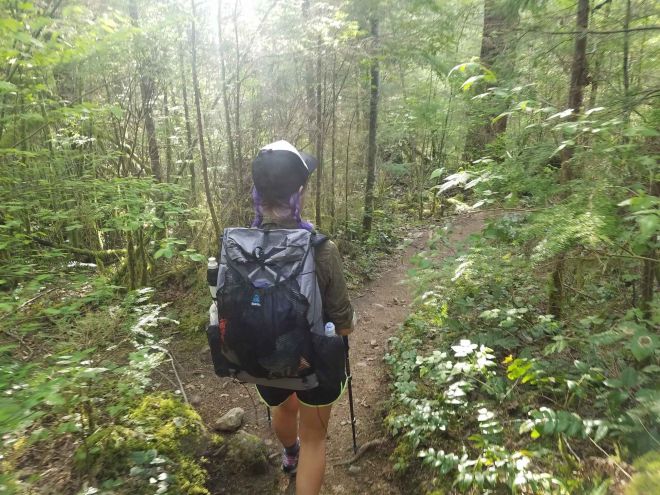
Big 3 Weight Total: 84oz. / 5lbs. 4oz.
Sleep Gear & Other Clothing
Everything to keep me toasty as I catch some Z’s.
- Therm-a-Rest Women’s Regular NeoAir XLite Sleeping Pad, 12 oz:
I bought this last year when I was trekking around Scotland, so it’s pretty tried and true. It seems thin, but it’s sturdy and has held up thus far. I find it pretty comfortable and lightweight, and it packs down relatively small (to about the size of a soda can). I almost always lay on my side and never on my back, so an inflatable pad is a must for me. I had previously used the popular Therm-a-rest Z-lite foam pad for the first 300 miles of my NOBO PCT thru-hike, but my hips were in agony daily and I traded it out once I got to Wrightwood. With the NeoAir, I usually wake up pain-free, so it’s staying with me for now. - Sleep & Camp Clothes, 14 oz: This includes my Helly Hansen HH Warm Long Underwear Bottoms, REI Mid Weight Merino Crew Socks, Mountain Hardware Ghost Whisperer Down Jacket, and Dakine Veronica Beanie. A detailed description of these clothing items can be found in my post “What I’m Wearing On My 2018 Thru-Hike.”
- Rain Gear and Spare Clothing, 10 oz: This would include my ULA Rain Skirt, REI Ultralight Rain Mitts, Outdoor Research Helium II Rain Jacket, cotton bandana, and an extra pair of Darn Tough Crew Socks. Please click the link above for further descriptions of these items.
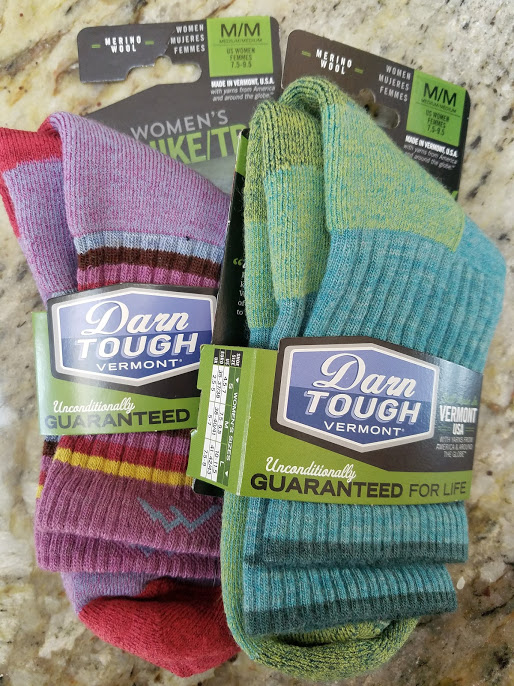
Note: Absent from this list is my wool sleep top from Smartwool and my fleece gloves. I’ve also upgraded my puffy jacket from Prana to the Ghost Whisperer from Mountain Hardware. I decided to ditch the wool sleep top and just wear my puffy if I get too cold at night. I’m doing this to reduce pack weight, plus it’s been relatively warm at night here in the PNW and don’t think that I’ll be needing it. I will probably add it once I reach the Sierra, as it gets pretty chilly above 10,000 feet at night during the months of September and October.
Sleep & Other Clothing Total Weight: 36 oz. / 2 lbs. 4 oz.


Cooking Gear, Food Storage & Water Purification
I still cook hot food, a shocking activity for the ultralight cold-soaking crew. I need my coffee to be hot, strong and plentiful in the mornings, and I don’t care what anyone thinks.

- MSR Titan Teakettle, 4 oz: This isn’t an actual teakettle, and I don’t know why they call it that. It’s a cook pot, plain and simple. I wouldn’t exactly call it ‘titan’ either; it has just under 1 liter liquid capacity, perfect for a single hiker who wants hot water for instant noodles or a drink.
- MSR PocketRocket 2 Stove, 2.6 oz: I had to replace my old PocketRocket this year, and I’m happy that MSR has improved on the original. I’ve always been a fan of this model of stove, mostly because of how easy it is to use and how tiny it is when folded.
- Sea to Summit Alpha Light Spork, .4 oz: It’s a spork, so not really much to say about it. It shovels food into my face pretty well.
- Sea to Summit X-Seal and Go Medium Container, 3 oz: This is essentially a collapsible silicone cup with a screw top lid. I got this for just in case I want to cold soak any food, but if I do, I will likely still heat it up once in camp so it’s more enjoyable. It will also serve as my coffee cup in the mornings.
- Sawyer Squeeze Water Filter, plus coupling attachment for cleaning and 2 Smartwater bottles, 7 oz: I’ve been a fan of the Sawyer Squeeze for some time now. It’s efficient, and I’ve never been sick from contaminated water thanks to it. I bought the coupling attachment for cleaning the filter while I was on my 2016 thru-hike, and it’s much easier and faster than trying to flush it out with the syringe that it comes with.
- Ursack Major Bear Bag, 8 oz: This is a fancy food bag that is made of a material called ‘Spectra,’ and is apparently bear proof. I don’t know this to be fact from first hand experience, but I do know that it is rodent proof. The PNW has its fair share of black bears, which are usually timid of humans and easy enough to scare off. However, nothing is as ferocious as the mice that lurk around the campsites of Washington. The bear bag will be replaced by a canister in the Sierra where it’s required, and the bear bag will be bounced ahead to either Kennedy Meadows or Lake Isabella (see below).
Total Cooking Gear, Food Storage and Water Purification Weight: 25oz. / 1 lb. 9oz.

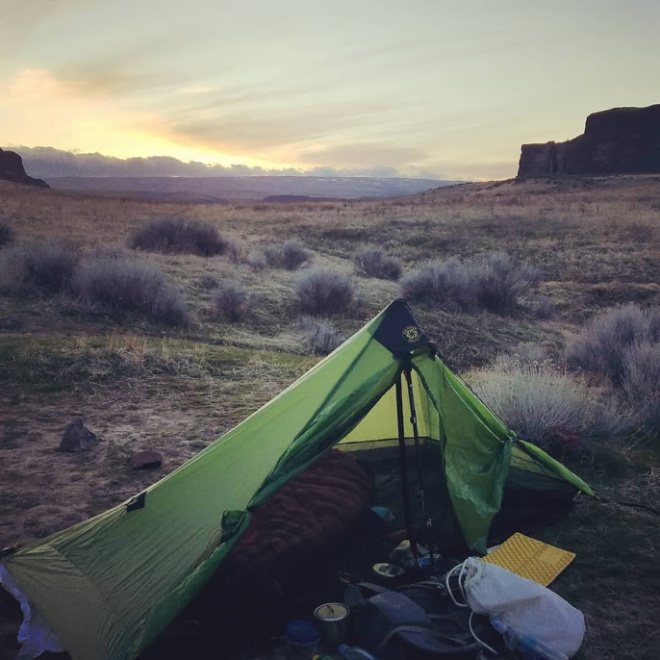
Gadgets
Thankfully apps weigh nothing!
- Samsung Galaxy S9+ with silicone shock case, battery bank, ear buds, wall charger and USB cord, 15oz: I hate how heavy all of this is, however, I don’t haul a bulky camera around and the camera on my phone is actually really good. I like checking in with my family and friends from time to time, and listening to audio books and music when the trail is monotonous, so I guess it’s a necessary evil.
- Princeton Tech Remix Headlamp, 3oz: This is just your run of the mill headlamp, with two light settings and nothing else.
- Luci Aura Inflatable Solar Lantern, 3oz: I picked this up in a small outfitter in a mountain town a couple of years back, and I’ve taken it on every trip since. It provides me a bit of comfort when I’m camping alone, because surely the rad color changing feature scares off any creatures that go bump in the night; RIGHT? It provides a soft light inside my shelter, for when I need to look at my maps and take notes after dark. I know it’s a bit of a luxury, but at only 3 ounces it’s staying.
Total Gadgets Weight: 21oz. / 1 lb. 5 oz.
Hygiene and First Aid
I pack a couple of things for keeping my hair tamed and for backcountry pooping, for an idea as to what I pack in my first aid kits when I’m thru-hiking, please visit my post “What’s in My First Aid Kit.”
- TheTentLab The Deuce #2 Backcountry Trowel, .6oz: It’s as light as a feather and great for digging holes to poop in. I’ve been using the same one for several years now, and it’s one of my favorite pieces of gear that make up my “Sh*t Kit.” So what’s in my Sh*t Kit? Just four things: The Deuce Trowel, a wad of toilet paper, a spare zip top bag for used TP, and a small travel size tube of hand sanitizer; all neatly stored away in a zip top bag and then tucked away in a convenient outer pouch for accessibility.
- Nail Clippers, >.5oz: Keep ’em short or lose ’em!
- Swiss Army Knife, 2oz: The classic! With 2 blades, tweezers, scissors and the ever important bottle opener.
Total Hygiene and First Aid Weight: >3oz.

Base Weight Total: 10 lbs. 9 oz.
Okay, so I’m just shy of that coveted “under 10 pound base weight” that so many ultralight hikers are seeking (and love to brag about). But you know what? I’m okay with that. My pack is still pretty darn light, even when weighted down with loads of food. And in comparison to my 2016 thru-hike, I’ve made leaps and bounds with my gear and getting smart with what I need and don’t need. Yes, I do like a few luxury items, like actual hot food and a cup to drink my coffee out of. I mean, call me crazy, but aren’t we supposed to be enjoying our journey out there?
As with any thru-hike, my gear will evolve and I might add some things and send some things packing. I will do my best to keep everyone updated in my trail journals, as well as in my post gear review once I’ve finished.
Variable Gear
This is the gear that I will only carry when needed, such as where it’s required by National Parks or when necessary for certain trail conditions.
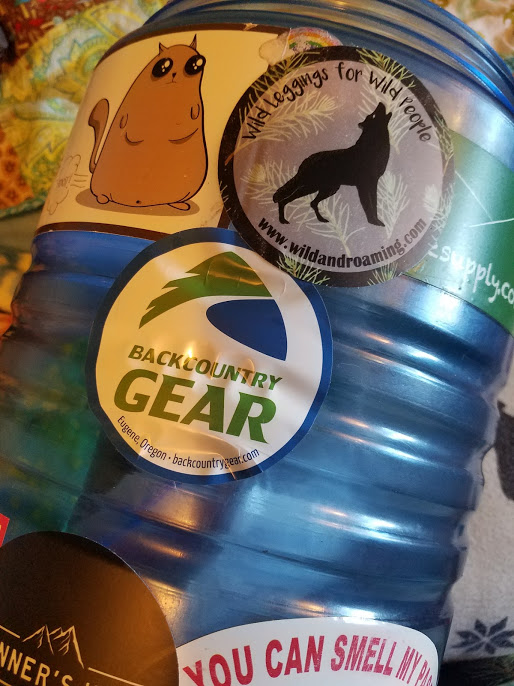
- C.A.M.P USA Corsa Ice Axe, 7 oz: Mainly for snow travel in the North Cascades. It’s uncertain if I will need to use it yet.
- Kahtoola Microspikes, 11oz: Again, these will be used mainly for snow travel in the North Cascades. I expect to send them home by the time I finish Washington Section J.
- BearVault BV500 Food Container, 41oz: It’s heavy, and my least favorite thing to carry, but it’s required through Yosemite and Sequoia Kings Canyon National Parks. I like bears and I want to protect them, so I follow the rules.
- Six Moons Designs Silver Shadow Trekking Umbrella, 8oz: I really like this umbrella; it’s light to carry, provides ample shade and has a reflective coating on the outside that sends that harsh sunshine back into outer space. I used it throughout the desert sections of Southern California during my 2016 NOBO thru-hike and it worked brilliantly. I’m unsure if I’ll be using it on my entire SOBO hike, but I’m fairly certain it will be making an appearance from mid Oregon and Northern California, or at least until I reach Sierra City. We’ll see, and I’ll keep you updated.
- Mosquito Head Net, 1oz: A must if you don’t want to go completely insane during the months of July and August in the PNW.



As always, I love hearing from you all! If you have any questions regarding gear, or if there’s a post you’d like me to do (resupply, food, recent trip reports, trail videos), please leave a comment below or shoot me an email.
I’m due to set off on my SOBO thru-hike in less than a month, with a trip to Glacier National Park somewhere in between now and then. I’ll do my best to respond to any inquiries quickly, but just know that I might be in the backcountry, so your patience is appreciated.
Don’t forget you can always follow my progress through my photography on Instagram.
Happy Trails,
-Artemis

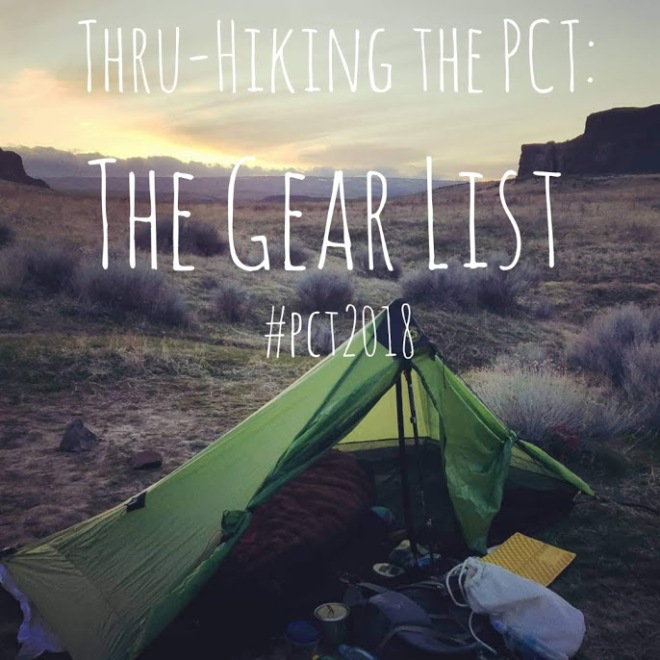

I’m astonished, from 63 inches on May 21 to 0 at Harts Pass today. The melt has been pretty steady, about two to three inches per day. There’s snow at Trout Lake and White Pass, and some at Skykomish and from the Canadian line to Stehekin but the coverage curve on Postholer is a lot more broken than I would have expected given the late May blast of cold temperatures. Seems as if this year’s snow water equivalents tracked the 1981-2010 average pretty well. Ain’t science wonderful?
LikeLike
1. I love love love these posts of yours!! For a teenager in England who dreams about hiking the PCT one day, these are so informative and accessible! 2. The range of lightweight gear in the States absolutely amazes me..how does all of this weigh less than I did when I was born??! My current ‘lightweight’ tent is almost 3kg!! Reading all of this gear with actual heart eyes!
LikeLike
Amelia, thanks for reading my posts! I’m glad you are enjoying them! I hope you make it to the PCT some day soon. Check out ultralightoutdoorgear.co.uk ; I bought my Therm-a-Rest sleep pad from them, as well as the rain kilt and a few other bits ‘n bobs when I was living in England and thru-hiked the South West Coast Path & trails in Scotland. They also have a decent selection of packs and shelters. You could also pre-order ultralight gear from US bases companies before you arrive to the states for your PCT journey, and have it sent to a trail angel or post office for pickup. The downside of that being you won’t get to properly test your gear before your thru-hike.
Thanks again for reading and let me know if there’s any questions you have regarding anything! Cheers!
-Artemis
LikeLike
Artemis, my pot cozy is ready to go, but am perplexed over responsibly disposing of isobutane canisters en route.
The MSR website offers some ideas which involve puncture and drop-off at a metals recycling center because many curbside recycling programs don’t effectively identify mixed metal. Aside from an ice axe, none of the suggested tools for puncturing canisters is likely to be included in the average pack. I doubt many trail towns are equipped to recycle canisters.
What’s the best option, pack ’em out until one returns to the city lights? Recycle British Columbia offers the same advice as MSR does, take them to a “proper depot”. Perhaps this leads one back to something like a Whisperlite stove until the outfitters team up with the recycling centers and figure it out.
It’s not your problem but you have a practical turn of mind, and you know more hikers than I do, so I thought I’d ask. What are others doing out there?
LikeLike
I believe most hikers just simply throw them in the trash when they’re finished, or toss them into a hiker box when they’re nearly finished. Recycling fuel canisters has always frustrated me. It would be a great service if REI could do it and clear up any confusion. I do know that a number of Oregon and Washington state parks have a recycling bin for canisters, but unfortunately they’re not many are near the PCT.
LikeLike
I have actually not yet finished reading this post, just want to let you know, that YES, I do want to read about trail town strategy, what you are packing and food budget! 🙂
LikeLike
Hi Eva, I’ll do my best to do a post regarding my resupply strategy & food budget. It may not happen until my thru-hike is finished unfortunately. Thanks for reading!
LikeLike
Interesting, Artemis, glad to hear about the efforts in WA and OR. Perhaps the USFS and BLM could consider expanding the program to include wilderness trailheads. What got me going down this line of thought was an article about controlling food debris over at mountaineers.org. What the heck, I’m already packing out the TP, so an incremental canister or two doesn’t amount to much. By the way, after my triumph with the pot cozy am due to get in the dehydration business. Thanks for all the pointers.
LikeLike
Artemis, great blog – so helpful! I’m planning on south bounding the PCT next year and I’d love to read about your food resupply plan. I live in Scotland so will need to hit the ground running when I arrive in the States so it would be really useful to read how you did it and how long it took you to get organised. x
LikeLike
Hi Shona, thanks for reading! I’ve had a few requests now for a post regarding my resupply plan/logistics, so I need to get busy! I’m creating a PDF spreadsheet at the moment, so stay tuned! Be sure to shoot me an email with any questions you have regarding the trail!
LikeLike
Greatt read thankyou
LikeLike